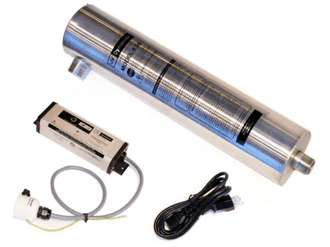UVD 240 Advanced Ultraviolet Water Disinfection

Product Features
- Flow rate of 8gpm (30L/min) delivers UV dose of 30mj/cm2
- Flow rate of 6gpm (23L/min) delivers UV dose of 40mj/cm2
- Passivated and polished 304 stainless steel reactor 3.5” x 18”
- 9000hr long life coated UV lamp
- Microprocessor controlled UV power source with audible and visible lamp failure alarms
- Annual lamp change timer
- Lamp life remaining feature
- ¾” MNPT fittings
- Domed quartz sleeve to simplify servicing
- No Tools required for regular servicing
- Easy-service lamp connector
Mini Rack Systems

PRODUCT FEATURES
- Available with 1, 2 or 3 filter housings
- Nominal 6 to 20 gpm (23 to 75 L/min) flow rates at 30mj UV dosenote1 ¾” porting
- Reversible mounting bracket
- Audio/visual lamp timer included on UV system
- Stainless steel https://affordablewatertreatments.com/communities-we-service/interconnect plumbing
- Available in stainless steel
- Optional floor stand for easy installation
Area’s we service
How Do UV Water Filters Work
UV radiation was first discovered on February 22, 1801, in Jena a German city by physicist Johann Wilhelm Ritter. We can thank Ritter for the creation of our current-day electrochemistry. Although he was ingenious in his field of expertise, a lot of his work wasn’t fully recognized for its true value until well after his death on January 23 1810.
It wasn’t till the mid-1800s that a Ultraviolet Disinfection System was applied for disinfecting hard surfaces. Finally, in 1908 France started to employ UVC light to sterilize and disinfect municipal water. This is a little bit of history about how UV water purification filters came to be commonplace in today’s water treatment marketplace.
Although UV light is very good at disinfecting and purifying water at a microscopic level, it doesn’t extract particles, and organic or inorganic compounds that might be dissolved in the water.
To know how ultraviolet light works you must understand what it does. UV light is actually radiation and has smaller wavelengths than the light we can see. It’s the invisible light we can’t see that destroys waterborne microorganisms such as E.coli, cryptosporidium, and giardia that can make you very sick if ingested. This invisible light goes after these threats and alters their DNA, destroying them from the inside out. This is why it is important to bring your water to a 5-micron position before passing it through the UV filter, so the microorganisms can’t hide behind something and survive.
The water that is generally treated with this filter is well water, and water found on the surface. A few of the nice things about UV disinfection is that it is fairly simple to understand, easy to operate, reasonably priced, and about 20,000 times more powerful than putting your water in a pot and boiling it. As long as the system is sized properly so you’re getting enough UV light, you can be confident that your water will be thoroughly disinfected in one pass through the filter. Exactly what you want when you’re treating potable water.
UV water purification is used in many different applications such as laboratories, aquaculture, hospitals, and several other industries. You have to keep in mind that there are applications where water has to be purified, and chlorine can’t be used because it may destroy other substances in the water. This is where UV purification really shines as it leaves no residue, doesn’t add anything to the water, and is proficient enough to wipe out 99.9% of the microorganisms in the water including pathogenic bacteria and viruses. In fact, one of the tools they used to control covid-19 was UV light.
Most water filtration systems usually have some moving parts in the water steam. such as pistons, flaps. turbines as a few examples. The problem with parts that move is they have to be inspected from time to time, and eventually replaced when they wear out. UV filters don’t have moving parts and the only part to replace is the UV bulb, and you have to clean the Quartz sleeve, usually about once a year. Not bad for a system that protects your water 24/7 around the clock, and has very little if any maintenance.
